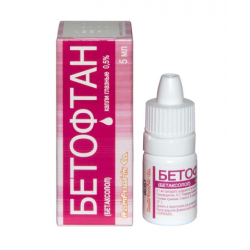



 All payments are encrypted via SSL
All payments are encrypted via SSL
 Full Refund if you haven't received your order
Full Refund if you haven't received your order
Eye drops
Betaxolol (in the form of hydrochloride) 5 mg
Excipients: sodium hydrogen phosphate dodecahydrate, sodium dihydrogen phosphate monohydrate, sodium chloride, disodium edetate dihydrate, benzalkonium chloride, purified water.
5 ml
BETOFTAN - antiglaucoma drug. Betaxolol is a selective beta1-blocker without internal sympathomimetic activity. Does not possess membrane stabilizing (local anesthetic) action.
When applied topically, betaxolol reduces both elevated and normal intraocular pressure, due to a decrease in the production of intraocular fluid. The onset of the hypotensive effect is usually observed 30 minutes after the use of the drug, and the maximum decrease in intraocular pressure occurs approximately 2 hours. After a single instillation, the effect on the intraocular pressure remains for 12 hours.
Betaxolol, compared with other beta-blockers, does not cause a decrease in blood flow in the optic nerve, miosis, accommodation spasm, hemeralopia (unlike miotics).
- ocular hypertension;
- chronic open-angle glaucoma;
- angle-closure glaucoma (in combination with miotics).
- sinus bradycardia;
- AV blockade II and III degree;
- sick sinus syndrome;
- children's age up to 18 years (due to the lack of data on efficacy and safety);
- hypersensitivity to the drug.
Carefully prescribe the drug for diabetes, thyrotoxicosis, simultaneous oral beta-blockers, Raynaud's syndrome, pheochromocytoma, bronchial asthma, chronic obstructive bronchitis, AV-blockade I degree, heart failure.
Instill 1-2 drops in the conjunctival sac 2 times / day. In some patients, stabilization of intraocular pressure occurs within a few weeks, therefore it is recommended to control intraocular pressure during the first month of treatment.
If the required level of intraocular pressure is not achieved with monotherapy with Betoftan, additional therapy should be prescribed.
Local reactions: short-term discomfort in the eyes after instillation, lacrimation; in some cases - lowering the sensitivity of the cornea, redness of the eye, keratitis, photophobia, anisocoria, blurred vision, itching, feeling of dry eyes, allergic reactions.
Systemic side effects are rare.
From the side of the central nervous system: dizziness, nausea, drowsiness, insomnia, headache, depression, increased symptoms of myasthenia.
Cardiovascular: bradycardia, impaired cardiac conduction and heart failure.
Respiratory: dyspnea, bronchospasm, bronchial asthma, respiratory failure.
With simultaneous use of the drug Betoftan and solution of adrenaline for ophthalmic use in some cases, the development of mydriasis is possible.
When using the drug Betoftan in combination with drugs that deplete catecholamine reserves (such as reserpine), there may be an increase in such effects as a decrease in blood pressure and bradycardia.
With simultaneous use of the drug Betoftan and beta-blockers for oral administration increases the risk of side effects (both local and systemic) due to the additive effect.
Caution must be exercised in the combined use of the drug Betoftan and adrenergic psychotropic drugs due to a possible increase in their action.
With the simultaneous appointment of muscle relaxants and hypoglycemic agents may increase their action.
When combined with sympathomimetics, there is an increase in their vasoconstrictor effect.
If necessary, it can be used in combination with other local ophthalmic preparations. In this case, the interval between their use should be at least 10 minutes.
At a temperature not higher than 25 ° С.
Betoftan ophthalmic